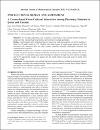Identifying areas of improvement for cultural competence in pharmacy curricula: A multi-school study using the self-assessment of perceived level of cultural competence (SAPLCC) questionnaire
| Author | Echeverri, Margarita |
| Author | Unni, Elizabeth |
| Author | Harpe, Spencer E. |
| Author | Kavookjian, Jan |
| Author | Alkhateeb, Fadi |
| Author | Ekong, Gladys |
| Author | Law, Anandi |
| Available date | 2023-05-11T06:44:42Z |
| Publication Date | 2021-10-01 |
| Publication Name | Currents in Pharmacy Teaching and Learning |
| Identifier | http://dx.doi.org/10.1016/j.cptl.2021.07.013 |
| ISSN | 18771297 |
| Abstract | Introduction: The implementation of culturally competent healthcare services has been considered a key strategy for the provision of patient-centered care; however, a need remains to address the requirements of teaching cultural competence, including identifying gaps, designing and evaluating curricula, and assessing students' progress toward program objectives. The objective of this study was to explore the applicability of the Self-Assessment of Perceived Level of Cultural Competence (SAPLCC) questionnaire in the identification of improvement areas in cultural competence content in pharmacy curricula. Methods: This study used previously-collected SAPLCC data from student pharmacists at eight United States pharmacy schools. Total and factor-specific SAPLCC scores were calculated based on the 14 factors published previously and grouped into six domains (knowledge, skills, attitudes, encounters, abilities, and awareness). Differences in overall scores by domain and factors across various student characteristics were examined using analysis of variance. Results: The overall mean total SAPLCC score was classified as moderate. Third-year students had significantly higher SAPLCC mean scores than first-year students, and African American students scored significantly higher than their counterparts. At the factor-level, students scored higher in the Attitudes and Awareness domains and scored lower in the Knowledge, Skills, and Encounters domains. Conclusions: The application of the SAPLCC in schools participating in this preliminary study allowed for the identification of content areas that may benefit from revision. The SAPLCC may be a useful tool for mapping cultural competence curricular content by each specific domain and identifying areas of potential improvement regarding cultural competence training within pharmacy curricula. |
| Sponsor | Dr. Margarita Echeverri's contribution was supported in part by funds from the Health Resources and Services Administration of the US Department of Health and Human Services under grant number (No.) D34HP00006; the Research Centers in Minority Institutions Program of the National Institute on Minority Health and Health Disparities (NIMHD) grant No. 2U54MD007595; the Xavier's NIMHD funded Center for Minority Health and Health Disparities Research and Education grant No. 5S21MD0000100, and the National Institute of General Medical Sciences' funded Louisiana Clinical and Translational Science Center grant No. U54GM104940. The contents and views in this manuscript are those of the authors and should not be construed to represent the views of the National Institutes of Health and other funders. |
| Language | en |
| Publisher | Elsevier |
| Subject | Cultural competence Cultural competence assessment Cultural competence curriculum Pharmacy education SAPLCC |
| Type | Article |
| Pagination | 1278-1287 |
| Issue Number | 10 |
| Volume Number | 13 |
Check access options
Files in this item
This item appears in the following Collection(s)
-
Pharmacy Research [1213 items ]





